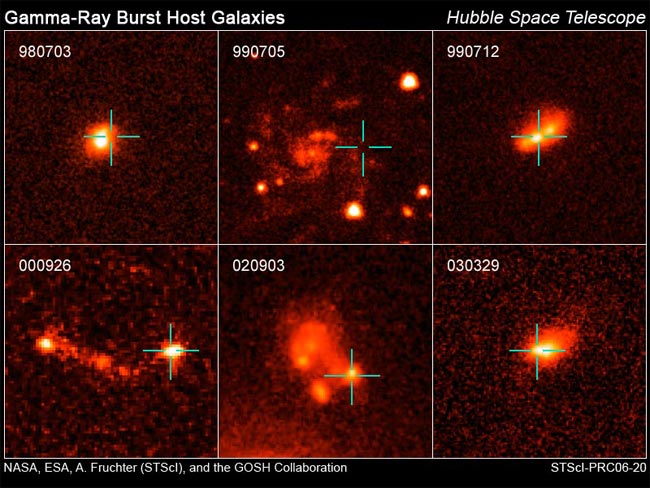Hubble Confirms Nearby Cosmic Blasts Unlikely

You can remove one potential threat from your worry list,based on new observations by the Hubble Space Telescope.
The observatory has been used to study long-durationgamma-ray bursts, which are powerful flashes of high-energy radiation thatemanate from some exploding stars. Astronomers have said before that if one ofthese flared up in our neck of the woods, Earth would be toasted and much oflife could be destroyed.
But it is unlikely one of these bursts will occur in ourMilky Way Galaxy, the new study finds.
The study, detailed in the May 11 issue of the journalNature, confirms similar work done with other telescopes and reportedlast month.
Long-duration gamma-ray bursts (those lasting more than acouple seconds) are related to the deaths of huge stars, those at least 20times as massive as our Sun and which are low on heavy elements.
Such stars are uncommon in our galaxy. They were prevalentwhen the universe was young, before multiple generations of stars created theheavier elements such as carbon and oxygen that are common to our galaxy. TheHubble study found the events tend to emanate from small, irregularly shapedgalaxies--those seen to exist before mergers had created the larger galaxiesseen in the nearby cosmos.
The upshot: Long-duration gamma-ray bursts tend to come fromvery, very far away, which in cosmic terms means they occurred long, long agoand the radiation is just reaching us after billions of years of traversing theuniverse.
Get the Space.com Newsletter
Breaking space news, the latest updates on rocket launches, skywatching events and more!
Of 42 bursts studied, only one came from a large spiralgalaxy like the Milky Way.
Modern massive stars, which are abundant in heavierelements, are unlikely to trigger long-duration gamma-ray bursts, also calledGRBs, the researchers explain. By the time they explode as supernovas, thesestars have already lost significant material through long-term outflows calledstellar winds. There is not enough mass left to create a burst when they gosupernova.
"It's a Goldilocks scenario," explained study leader AndrewFruchter of the Space Telescope Science Institute. "Only supernovae whoseprogenitor stars have lost some, but not too much, mass appear to be candidatesfor the formation of GRBs."
Short-duration gamma-ray bursts, lasting less then twoseconds and sometimes just milliseconds, can occur in our galaxy. Collisionsbetween neutron stars can create them, for example. They are 100 to 1,000 timesless powerful, however.
Join our Space Forums to keep talking space on the latest missions, night sky and more! And if you have a news tip, correction or comment, let us know at: community@space.com.

Rob has been producing internet content since the mid-1990s. He was a writer, editor and Director of Site Operations at Space.com starting in 1999. He served as Managing Editor of LiveScience since its launch in 2004. He then oversaw news operations for the Space.com's then-parent company TechMediaNetwork's growing suite of technology, science and business news sites. Prior to joining the company, Rob was an editor at The Star-Ledger in New Jersey. He has a journalism degree from Humboldt State University in California, is an author and also writes for Medium.









